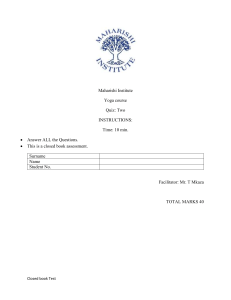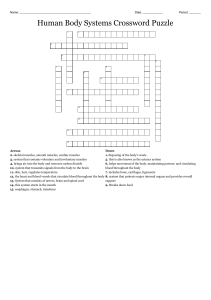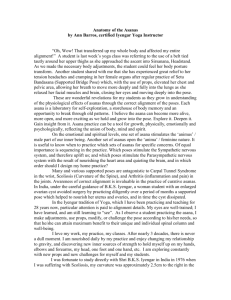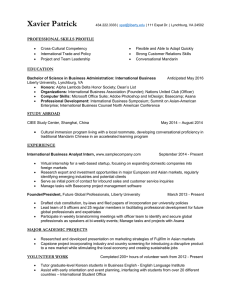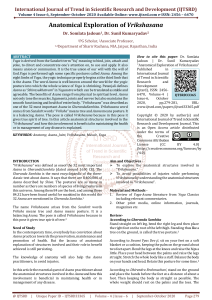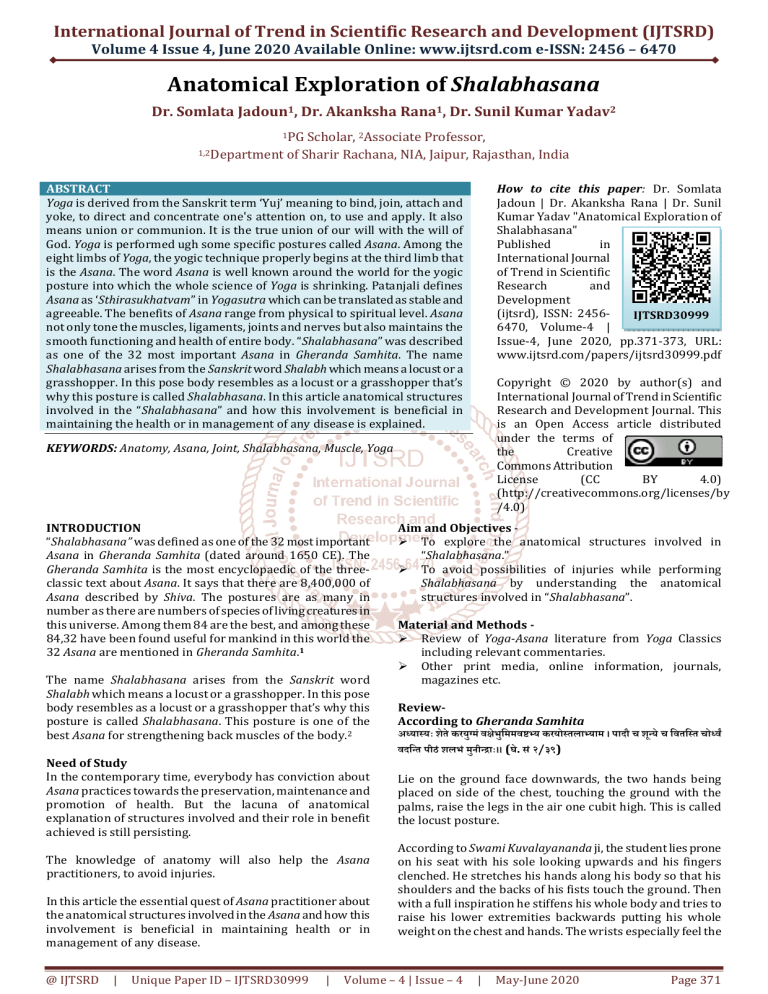
International Journal of Trend in Scientific Research and Development (IJTSRD) Volume 4 Issue 4, June 2020 Available Online: www.ijtsrd.com e-ISSN: 2456 – 6470 Anatomical Exploration of Shalabhasana Dr. Somlata Jadoun1, Dr. Akanksha Rana1, Dr. Sunil Kumar Yadav2 1PG Scholar, 2Associate Professor, 1,2Department of Sharir Rachana, NIA, Jaipur, Rajasthan, India How to cite this paper: Dr. Somlata Jadoun | Dr. Akanksha Rana | Dr. Sunil Kumar Yadav "Anatomical Exploration of Shalabhasana" Published in International Journal of Trend in Scientific Research and Development (ijtsrd), ISSN: 2456IJTSRD30999 6470, Volume-4 | Issue-4, June 2020, pp.371-373, URL: www.ijtsrd.com/papers/ijtsrd30999.pdf ABSTRACT Yoga is derived from the Sanskrit term ‘Yuj’ meaning to bind, join, attach and yoke, to direct and concentrate one's attention on, to use and apply. It also means union or communion. It is the true union of our will with the will of God. Yoga is performed ugh some specific postures called Asana. Among the eight limbs of Yoga, the yogic technique properly begins at the third limb that is the Asana. The word Asana is well known around the world for the yogic posture into which the whole science of Yoga is shrinking. Patanjali defines Asana as ‘Sthirasukhatvam” in Yogasutra which can be translated as stable and agreeable. The benefits of Asana range from physical to spiritual level. Asana not only tone the muscles, ligaments, joints and nerves but also maintains the smooth functioning and health of entire body. “Shalabhasana” was described as one of the 32 most important Asana in Gheranda Samhita. The name Shalabhasana arises from the Sanskrit word Shalabh which means a locust or a grasshopper. In this pose body resembles as a locust or a grasshopper that’s why this posture is called Shalabhasana. In this article anatomical structures involved in the “Shalabhasana” and how this involvement is beneficial in maintaining the health or in management of any disease is explained. Copyright © 2020 by author(s) and International Journal of Trend in Scientific Research and Development Journal. This is an Open Access article distributed under the terms of the Creative Commons Attribution License (CC BY 4.0) (http://creativecommons.org/licenses/by /4.0) KEYWORDS: Anatomy, Asana, Joint, Shalabhasana, Muscle, Yoga INTRODUCTION “Shalabhasana” was defined as one of the 32 most important Asana in Gheranda Samhita (dated around 1650 CE). The Gheranda Samhita is the most encyclopaedic of the threeclassic text about Asana. It says that there are 8,400,000 of Asana described by Shiva. The postures are as many in number as there are numbers of species of living creatures in this universe. Among them 84 are the best, and among these 84,32 have been found useful for mankind in this world the 32 Asana are mentioned in Gheranda Samhita.1 The name Shalabhasana arises from the Sanskrit word Shalabh which means a locust or a grasshopper. In this pose body resembles as a locust or a grasshopper that’s why this posture is called Shalabhasana. This posture is one of the best Asana for strengthening back muscles of the body.2 Need of Study In the contemporary time, everybody has conviction about Asana practices towards the preservation, maintenance and promotion of health. But the lacuna of anatomical explanation of structures involved and their role in benefit achieved is still persisting. The knowledge of anatomy will also help the Asana practitioners, to avoid injuries. In this article the essential quest of Asana practitioner about the anatomical structures involved in the Asana and how this involvement is beneficial in maintaining health or in management of any disease. @ IJTSRD | Unique Paper ID – IJTSRD30999 | Aim and Objectives To explore the anatomical structures involved in “Shalabhasana.” To avoid possibilities of injuries while performing Shalabhasana by understanding the anatomical structures involved in “Shalabhasana”. Material and Methods Review of Yoga-Asana literature from Yoga Classics including relevant commentaries. Other print media, online information, journals, magazines etc. ReviewAccording to Gheranda Samhita अयायः शेते करयु मं वेभुिममवय करयोतलायाम । पादौ च शूये च िवतित चोव वदित पीठं शलभं मुनी#ाः।। (घे. सं २/३९) Lie on the ground face downwards, the two hands being placed on side of the chest, touching the ground with the palms, raise the legs in the air one cubit high. This is called the locust posture. According to Swami Kuvalayananda ji, the student lies prone on his seat with his sole looking upwards and his fingers clenched. He stretches his hands along his body so that his shoulders and the backs of his fists touch the ground. Then with a full inspiration he stiffens his whole body and tries to raise his lower extremities backwards putting his whole weight on the chest and hands. The wrists especially feel the Volume – 4 | Issue – 4 | May-June 2020 Page 371 International Journal of Trend in Scientific Research and Development (IJTSRD) @ www.ijtsrd.com eISSN: 2456-6470 burden of the lifted legs. Throughout the exercise the breath is held in and the knees are kept stiff and straight.3 Swami Satyananda Saraswati ji explains Shalabhasana, Lie flat on the stomach with the legs and feet together and the soles of the feet uppermost. The arms may be placed either under the body or by the sides, with the palms downward or the hands clenched. Stretch the chin slightly forward and rest it on the floor throughout the practice. Close the eyes and relax the body. This is the starting position. Slowly raise the legs as high as possible without straining, keeping them straight and together. The elevation of the legs is produced by applying pressure with the arms against the floor and contracting the lower back muscles. Hold the final position for as long as is comfortable without strain. Slowly lower the legs to the floor. This is one round. Return to the starting position and relax the body with the head turned to one side. Allow the respiration and heartbeat to return to normal. Breathing-Inhale deeply in the starting position. Retain the breath inside while raising the legs and holding the position. Exhale while lowering the legs. Beginners may find it helpful to inhale while raising the legs. Advanced practitioners may exhale after returning to the starting position.4 According to Dhirendra Brahmachari, lie on the abdomen and place the palms near the shoulders, feet should be joined together and the body should be raised from the ground as much as possible, above and below the waist. The body from the waist to the feet should be erect.5 B.K.S Iyengar also explain Shalabhasana, lie full length on the floor on the stomach, face downwards. Stretch the arms back. Exhale, lift the head, chest and legs off the floor simultaneously as high as possible. The hands should not be placed and the ribs should not rest on the floor. Only the abdominal front portion of the body rests on the floor and bears the weight of the body. Contract the buttocks and stretch the thigh muscles. Keep both legs fully extended and straight, touching at the thighs, knees and ankles. Do not bear the weight of the body on the hands but stretch them back to exercise the upper portion of the back muscles. Stay in the position as long as you can with normal breathing. In the beginning it is difficult to lift the chest and the legs off the floor, but this becomes easier as the abdominal muscles grow stronger.6 Steps for Performing “Shalabhasana”7 Lie down on the floor on the stomach, face downwards. Stretch the arms back. Lift the head, chest and legs off the floor simultaneously as high as possible. The hands should not be placed and the ribs should not rest on the floor. Only the abdominal portion of the body rest on the floor and bears the weight of the body. Contract the buttocks and stretch the thigh muscles. Keep both legs fully extended and straight. Do not bear the weight of the body on the hands but stretch them back to exercise the upper portion of the back muscles. Stay in the position as long as you can with normal breathing. @ IJTSRD | Unique Paper ID – IJTSRD30999 | Image: Anatomical Exploration of ShalabhasanaMuscles and ligaments involved in Shalabhasana. Joint actions The ankles are plantarflexed. The knees are extended. The hips are extended, medially rotated and adducted. The spine is extended. The shoulder joint is flexed and externally rotated. The elbows are extended. The forearms are pronated. Muscles and ligaments involved in Shalabhasana Ankle and foot region In Shalabhasana ankles are planter flexed and foot inverted. Ankle planter flexion is done by the gastrocnemius, soleus and it is assisted by the Plantaris, tibialis posterior, flexor hallucis longus and flexor digitorum longus. Feet are inverted by tibialis anterior and posterior. The muscles acting as antagonists for this action are muscles of anterior and lateral compartment of leg and dorsum of foot. Anterior compartment of leg comprises of extensor digitorum longus, extensor hallucis longus, tibialis anterior and peroneus. Ligaments of Ankle joint Foot is inverted hence the lateral collateral ligaments are stretched here these includes Anterior talofibular ligaments (ATFL) Posterior talofibular ligaments (PTFL) Calcaneofibular ligament Knee region In Shalabhasana knee joints are extended. Muscles which works on knee extension are quadriceps femoris (four heads- vastus lateralis, vastus medialis, vastus intermedialis and biceps femoris). And it is assisted by tensor fasciae latae and articularis genu. The Flexor compartment or posterior compartment of thigh is stretched when the knee is extended. This comprises of the hamstring muscles which crosses the knee and hip joints. This hamstring group of muscles comprises of Semitendinosus, semimembranosus and biceps femoris. To sustain the extended position of the knees the extensors of knee are in active contraction. The quadriceps femoris muscle as a whole keep the knees extended. These include rectus femoris, vastus medialis, intermedialis and lateralis. Ligaments of knee joint Knee joint is extended. In this position the maximum pressure is on the following ligaments. Anterior and Posterior cruciate ligament (ACL and PCL) Medial and Lateral collateral ligament (MCL and LCL) Volume – 4 | Issue – 4 | May-June 2020 Page 372 International Journal of Trend in Scientific Research and Development (IJTSRD) @ www.ijtsrd.com eISSN: 2456-6470 Hip region Hip joints are extended, medially rotated and adducted at the time of performing Shalabhasana. The main muscles worked in the hip extension are the gluteus maximus and hamstrings. Gluteus Maximus is a primary muscle of the hip extension. The other hip extensors are long head of biceps femoris, semimembranosus, semitendinosus and posterior adductor magnus. So, the flexor of the hip joint will get stretch. The flexors of hip joint are Sartorius, vastus lateralis, vastus medialis and vastus intermedius. Adduction is performed by the adductors of the hip joint which are three groups of adductors, pectineus and gracilis. The Spine The spine is extended in Shalabhasana. All extensors of the back along with external oblique and transverse abdominus are contracted in Shalabhasana. These include the erector spinae muscles, transvers spinalis muscles, quadratus lumborum and Levator costarum. The thoracic and lumbar spines are in extension. The muscles of anterior abdominal wall help in the Extension of trunk. These includes rectus abdominus, external oblique abdominus and internal oblique abdominus. Shoulder joint Shoulder joint is externally rotated in Shalabhasana. External rotation of the shoulder joint is done by the infraspinatus, teres minor and posterior fibres of deltoid. Since the shoulder joint is externally rotated there will be minor stretching of the antagonist muscles. Elbow region Elbow extended and Forearm pronated in Shalabhasana. Extension of elbow joint is done by the triceps brachii and anconeus, and pronation of radioulnar joint is done by the pronator teres and pronator quadratus. In Shalabhasana the upper limb is kept straight and the elbow is extended. The forearm is in pronated position. To maintain the extension of elbow joint the triceps brachii is actively contracted. BenefitsShalabhasana is a fine exercise for the pelvis and the abdomen.8 Shalabhasana strengthens the lower back and pelvic organs, and provides relief from backache, mild sciatica and slipped disc as long as the condition is not serious. It tones and balances the functioning of the liver, stomach, bowels and other abdominal organs, and stimulates the appetite. It tightens the muscles of the buttocks and causes the body to do Vajroli Mudra spontaneously.9 The chest broadens through the practice of this Asana the waist becomes resilient and supple. It is also very useful for the shoulders and abdomen. It relieves constipation and stimulates digestion.10 The pose aids digestion and relieves gastric troubles and flatulence. Since the spine is stretched back it becomes elastic and the pose relieves pain in the sacral and lumbar regions. In my experience, persons suffering from slipped discs have benefited by regular practice of this Asana without recourse to enforced rest or surgical treatment. The bladder and the prostate gland also benefit from the exercise and remain healthy.11 @ IJTSRD | Unique Paper ID – IJTSRD30999 | Discussion The basic joint position in Shalabhasana are the ankles plantar flexed, feet are inverted, knees extended and hips are extended, adducted and medially rotate. The lumbar and thoracic spine extended, cervical spine extended, shoulder joint flexed, externally rotated, The Elbows are in extended and prone position. While lifting the legs and extending the hip it activates the gluteus muscles, adductors hamstrings and calves. By practicing Shalabhasana, pressure exerted on the lower abdominal region, hips and thighs. This helps in getting rid of unnecessary fat around the hips, abdominal region and thighs. In Shalabhasana spine is extended and all extensors of back contracted. This helps in strengthens and provides flexibility to the spine and back muscles. Shalabhasana can balances Manipura Chakra. Manipura Chakra is situated at solar region, which is located at the back of stomach or the upper abdomen. The solar plexus Chakra is known as the Manipur Chakra, it is associated with the digestive and metabolic process of of the human body. In this Asana due to raised intra-abdominal pressure this stimulates the secretion of liver and pancreas. Conclusion In Shalabhasana hip joints, abdominal muscles are in maximum stress. So, it advantages to strengthens back muscle and curing disorders like sciatica and backache. Shalabhasana extends and strengthens the spine and make it more flexible. Regular practice of Shalabhasana will keep spine in good state and open up the chest resulting in improved breathing. Shalabhasana strengthens the abdominal muscles and tones the abdominal organs like liver and spleen. The pressure applied on these areas also massages the organs. It releases the constipation, indigestion and gets the digestive process function more optimally. References[1] The Gheranda Samhita translated in English by Rai Bahadur Srisa Chandra Vasu; published by Sri Satguru Publications; New Delhi; Reprint 1979 [2] Saraswati SS. Asana Pranayama Mudra Bandha. Fourth Edi. Munger: Yoga Publication Trust; 2009. [3] Kuvalayananda, S. (2012). Asanas (Eighth Edi) Lonavala: Kaivalyadhama S.M.Y.M Samiti. Page 62 [4] Saraswati SS. Asana Pranayama Mudra Bandha. Fourth Edi. Munger: Yoga Publication Trust; 2009. Page 205 [5] Brahmachari D. Science of Yoga (Yogasana Vijnana). First Edit. Mumbai: Asia Publishing House; 1970. page 84 [6] Iyengar BKS. Light on Yoga. revised ed. Schocken Books New York; 1979 page 99 [7] Saraswati SS. Asana Pranayama Mudra Bandha. Fourth Edi. Munger: Yoga Publication Trust;2009. Page 211 [8] Kuvalayananda, S. (2012). Asanas (Eighth Edi) Lonavala: Kaivalyadhama S.M.Y.M Samiti. Page 62 [9] Saraswati SS. Asana Pranayama Mudra Bandha. Fourth Edi. Munger: Yoga Publication Trust; 2009. Page 206 [10] Brahmachari D. Science of Yoga (Yogasana Vijnana). First Edit. Mumbai: Asia Publishing House; 1970. page 84 [11] Iyengar BKS. Light on Yoga. revised ed. Schocken Books New York; 1979 page 99 Volume – 4 | Issue – 4 | May-June 2020 Page 373
